Quality Assurance and Good Manufacturing Practices - Analysis
VerifiedAdded on 2020/10/04
|16
|3912
|83
Homework Assignment
AI Summary
This assignment delves into the critical aspects of Quality Assurance (QA) and Good Manufacturing Practices (GMP) within the healthcare sector. It encompasses a detailed examination of QA, its proactive approach to ensuring product and service quality, and its distinction from Quality Control (QC). The document outlines the significance of GMP in minimizing risks and ensuring adherence to quality standards, touching upon regulatory agencies like MHRA, Medicines Control Council, ICH, PIC's, and TGA. The analysis further explores the Safe Medical Devices Act, the roles of potency and sterility, and the handling of biological products and related standards. It covers the principles and regulatory elements of QA, GMP guidelines for premises and equipment, personnel qualifications, and specific manufacturing requirements for drugs like penicillin. The assignment also examines validation processes, SUPAC, calibration methods, and the elements of a validation protocol. Overall, the assignment provides a comprehensive overview of the practices and regulations essential for maintaining product quality and safety in the healthcare and pharmaceutical industries.
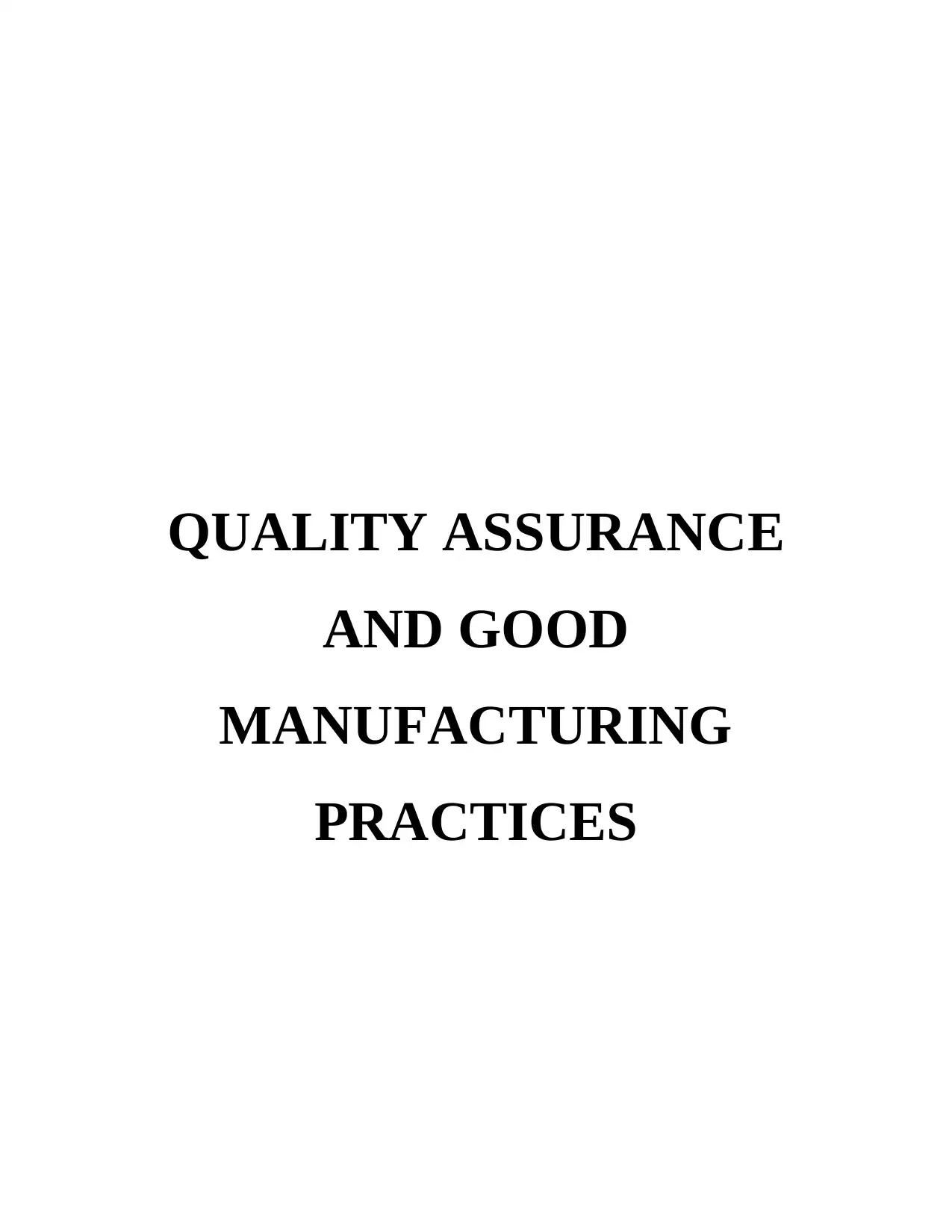
QUALITY ASSURANCE
AND GOOD
MANUFACTURING
PRACTICES
AND GOOD
MANUFACTURING
PRACTICES
Paraphrase This Document
Need a fresh take? Get an instant paraphrase of this document with our AI Paraphraser
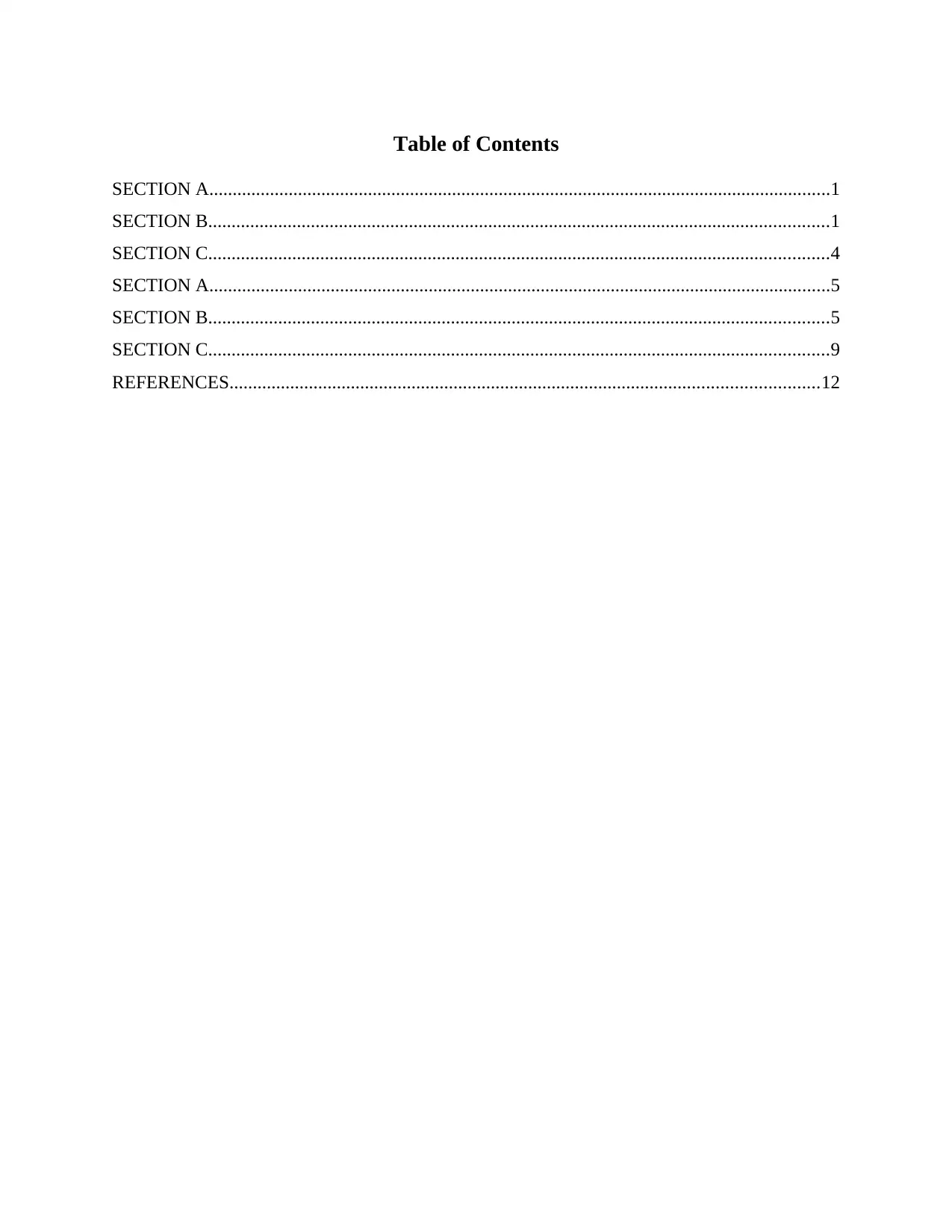
Table of Contents
SECTION A.....................................................................................................................................1
SECTION B.....................................................................................................................................1
SECTION C.....................................................................................................................................4
SECTION A.....................................................................................................................................5
SECTION B.....................................................................................................................................5
SECTION C.....................................................................................................................................9
REFERENCES..............................................................................................................................12
SECTION A.....................................................................................................................................1
SECTION B.....................................................................................................................................1
SECTION C.....................................................................................................................................4
SECTION A.....................................................................................................................................5
SECTION B.....................................................................................................................................5
SECTION C.....................................................................................................................................9
REFERENCES..............................................................................................................................12
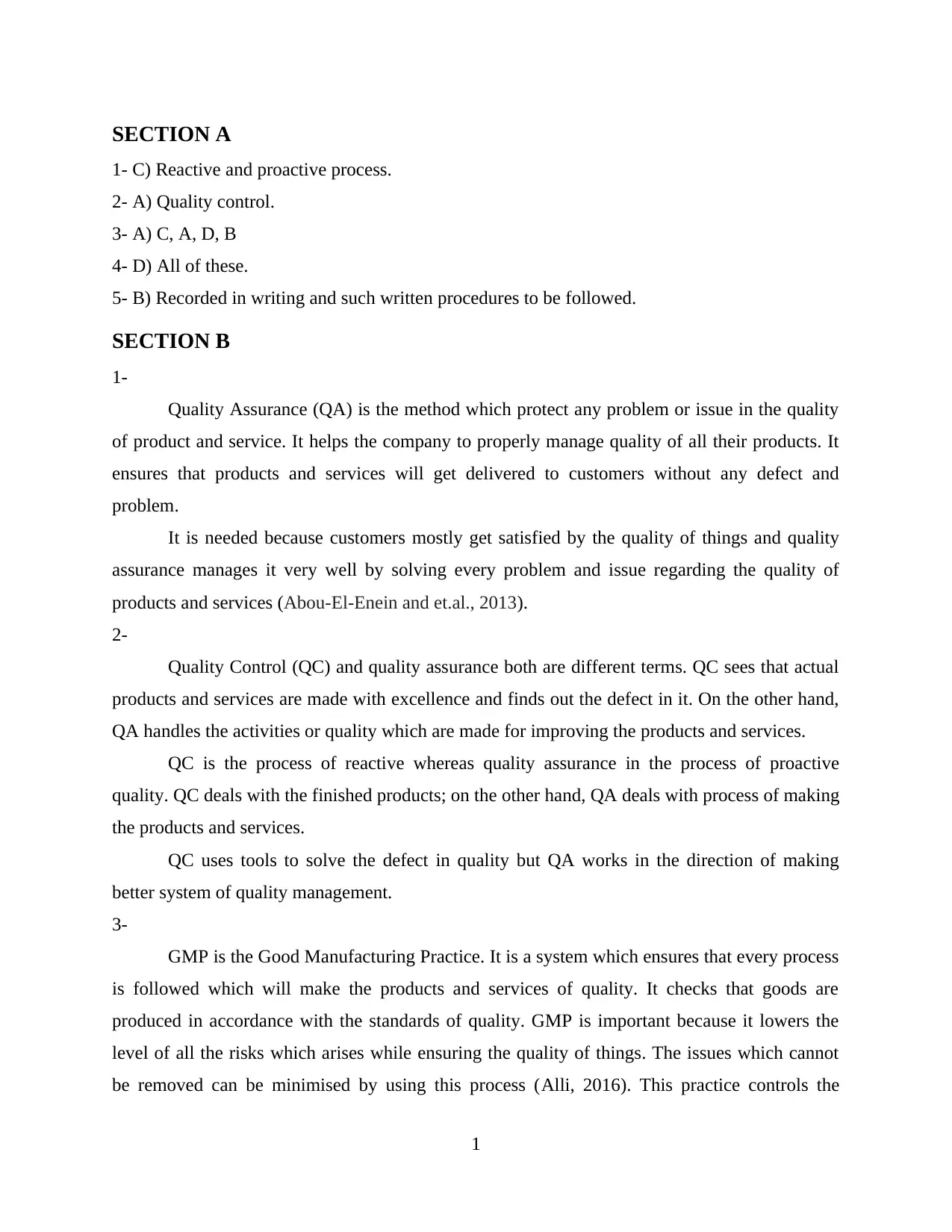
SECTION A
1- C) Reactive and proactive process.
2- A) Quality control.
3- A) C, A, D, B
4- D) All of these.
5- B) Recorded in writing and such written procedures to be followed.
SECTION B
1-
Quality Assurance (QA) is the method which protect any problem or issue in the quality
of product and service. It helps the company to properly manage quality of all their products. It
ensures that products and services will get delivered to customers without any defect and
problem.
It is needed because customers mostly get satisfied by the quality of things and quality
assurance manages it very well by solving every problem and issue regarding the quality of
products and services (Abou-El-Enein and et.al., 2013).
2-
Quality Control (QC) and quality assurance both are different terms. QC sees that actual
products and services are made with excellence and finds out the defect in it. On the other hand,
QA handles the activities or quality which are made for improving the products and services.
QC is the process of reactive whereas quality assurance in the process of proactive
quality. QC deals with the finished products; on the other hand, QA deals with process of making
the products and services.
QC uses tools to solve the defect in quality but QA works in the direction of making
better system of quality management.
3-
GMP is the Good Manufacturing Practice. It is a system which ensures that every process
is followed which will make the products and services of quality. It checks that goods are
produced in accordance with the standards of quality. GMP is important because it lowers the
level of all the risks which arises while ensuring the quality of things. The issues which cannot
be removed can be minimised by using this process (Alli, 2016). This practice controls the
1
1- C) Reactive and proactive process.
2- A) Quality control.
3- A) C, A, D, B
4- D) All of these.
5- B) Recorded in writing and such written procedures to be followed.
SECTION B
1-
Quality Assurance (QA) is the method which protect any problem or issue in the quality
of product and service. It helps the company to properly manage quality of all their products. It
ensures that products and services will get delivered to customers without any defect and
problem.
It is needed because customers mostly get satisfied by the quality of things and quality
assurance manages it very well by solving every problem and issue regarding the quality of
products and services (Abou-El-Enein and et.al., 2013).
2-
Quality Control (QC) and quality assurance both are different terms. QC sees that actual
products and services are made with excellence and finds out the defect in it. On the other hand,
QA handles the activities or quality which are made for improving the products and services.
QC is the process of reactive whereas quality assurance in the process of proactive
quality. QC deals with the finished products; on the other hand, QA deals with process of making
the products and services.
QC uses tools to solve the defect in quality but QA works in the direction of making
better system of quality management.
3-
GMP is the Good Manufacturing Practice. It is a system which ensures that every process
is followed which will make the products and services of quality. It checks that goods are
produced in accordance with the standards of quality. GMP is important because it lowers the
level of all the risks which arises while ensuring the quality of things. The issues which cannot
be removed can be minimised by using this process (Alli, 2016). This practice controls the
1
⊘ This is a preview!⊘
Do you want full access?
Subscribe today to unlock all pages.

Trusted by 1+ million students worldwide
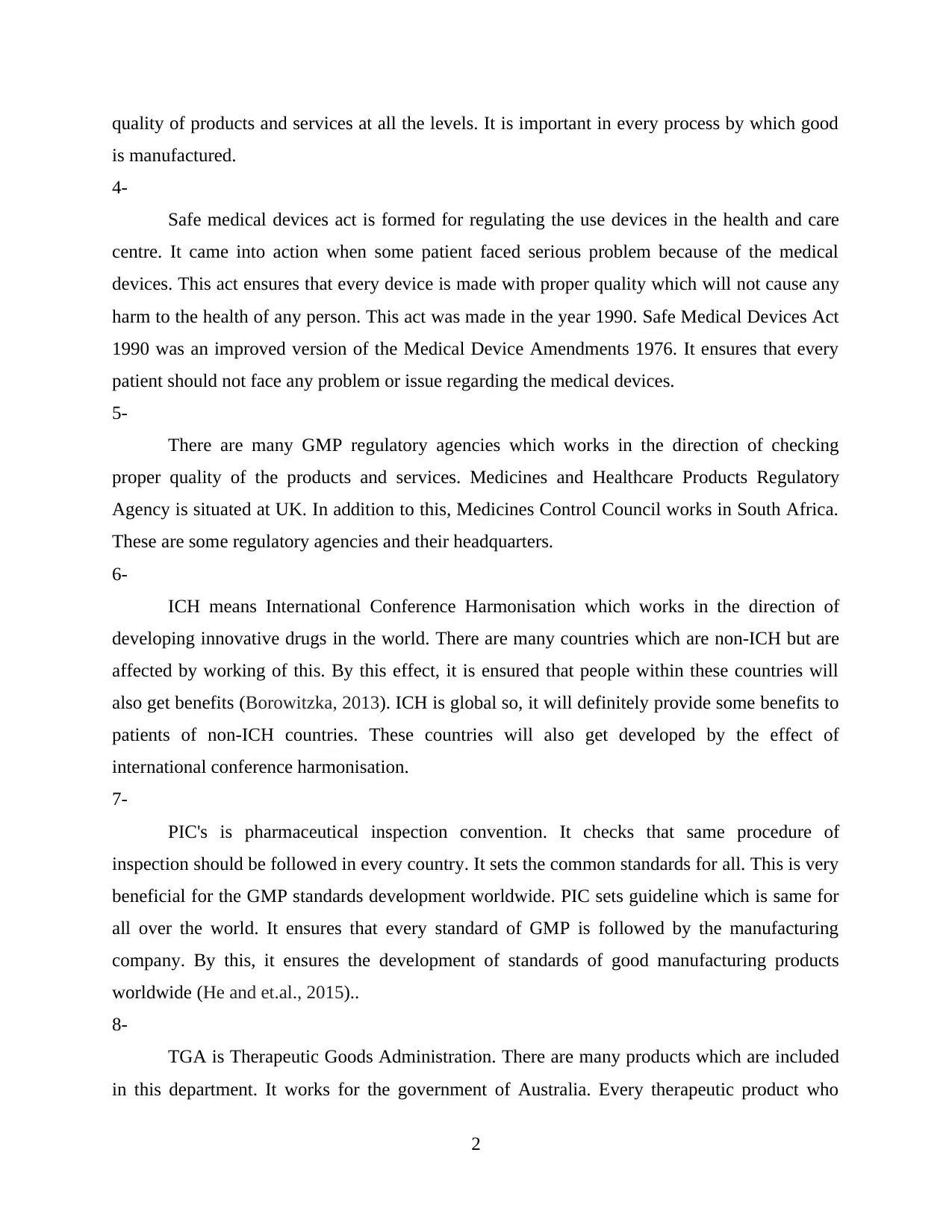
quality of products and services at all the levels. It is important in every process by which good
is manufactured.
4-
Safe medical devices act is formed for regulating the use devices in the health and care
centre. It came into action when some patient faced serious problem because of the medical
devices. This act ensures that every device is made with proper quality which will not cause any
harm to the health of any person. This act was made in the year 1990. Safe Medical Devices Act
1990 was an improved version of the Medical Device Amendments 1976. It ensures that every
patient should not face any problem or issue regarding the medical devices.
5-
There are many GMP regulatory agencies which works in the direction of checking
proper quality of the products and services. Medicines and Healthcare Products Regulatory
Agency is situated at UK. In addition to this, Medicines Control Council works in South Africa.
These are some regulatory agencies and their headquarters.
6-
ICH means International Conference Harmonisation which works in the direction of
developing innovative drugs in the world. There are many countries which are non-ICH but are
affected by working of this. By this effect, it is ensured that people within these countries will
also get benefits (Borowitzka, 2013). ICH is global so, it will definitely provide some benefits to
patients of non-ICH countries. These countries will also get developed by the effect of
international conference harmonisation.
7-
PIC's is pharmaceutical inspection convention. It checks that same procedure of
inspection should be followed in every country. It sets the common standards for all. This is very
beneficial for the GMP standards development worldwide. PIC sets guideline which is same for
all over the world. It ensures that every standard of GMP is followed by the manufacturing
company. By this, it ensures the development of standards of good manufacturing products
worldwide (He and et.al., 2015)..
8-
TGA is Therapeutic Goods Administration. There are many products which are included
in this department. It works for the government of Australia. Every therapeutic product who
2
is manufactured.
4-
Safe medical devices act is formed for regulating the use devices in the health and care
centre. It came into action when some patient faced serious problem because of the medical
devices. This act ensures that every device is made with proper quality which will not cause any
harm to the health of any person. This act was made in the year 1990. Safe Medical Devices Act
1990 was an improved version of the Medical Device Amendments 1976. It ensures that every
patient should not face any problem or issue regarding the medical devices.
5-
There are many GMP regulatory agencies which works in the direction of checking
proper quality of the products and services. Medicines and Healthcare Products Regulatory
Agency is situated at UK. In addition to this, Medicines Control Council works in South Africa.
These are some regulatory agencies and their headquarters.
6-
ICH means International Conference Harmonisation which works in the direction of
developing innovative drugs in the world. There are many countries which are non-ICH but are
affected by working of this. By this effect, it is ensured that people within these countries will
also get benefits (Borowitzka, 2013). ICH is global so, it will definitely provide some benefits to
patients of non-ICH countries. These countries will also get developed by the effect of
international conference harmonisation.
7-
PIC's is pharmaceutical inspection convention. It checks that same procedure of
inspection should be followed in every country. It sets the common standards for all. This is very
beneficial for the GMP standards development worldwide. PIC sets guideline which is same for
all over the world. It ensures that every standard of GMP is followed by the manufacturing
company. By this, it ensures the development of standards of good manufacturing products
worldwide (He and et.al., 2015)..
8-
TGA is Therapeutic Goods Administration. There are many products which are included
in this department. It works for the government of Australia. Every therapeutic product who
2
Paraphrase This Document
Need a fresh take? Get an instant paraphrase of this document with our AI Paraphraser
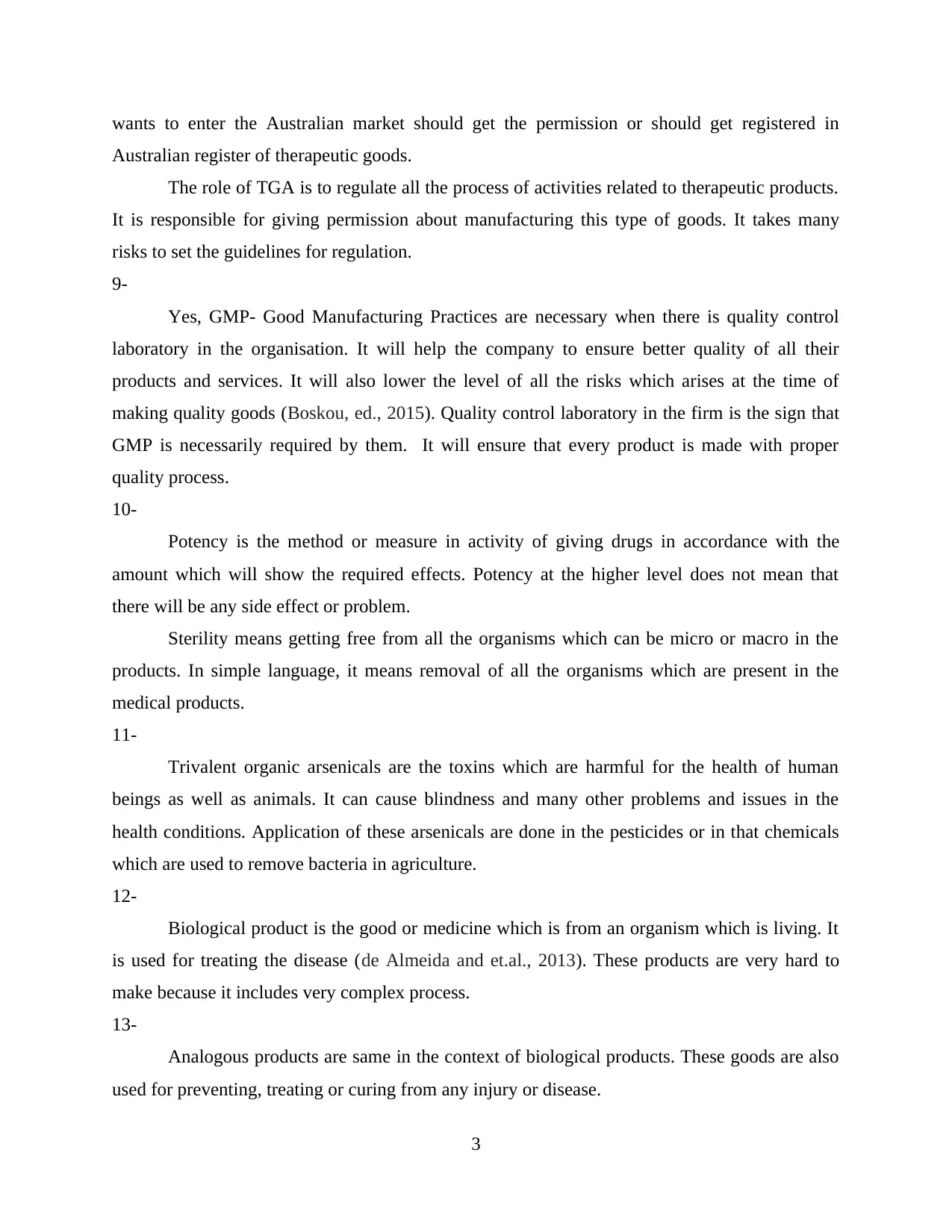
wants to enter the Australian market should get the permission or should get registered in
Australian register of therapeutic goods.
The role of TGA is to regulate all the process of activities related to therapeutic products.
It is responsible for giving permission about manufacturing this type of goods. It takes many
risks to set the guidelines for regulation.
9-
Yes, GMP- Good Manufacturing Practices are necessary when there is quality control
laboratory in the organisation. It will help the company to ensure better quality of all their
products and services. It will also lower the level of all the risks which arises at the time of
making quality goods (Boskou, ed., 2015). Quality control laboratory in the firm is the sign that
GMP is necessarily required by them. It will ensure that every product is made with proper
quality process.
10-
Potency is the method or measure in activity of giving drugs in accordance with the
amount which will show the required effects. Potency at the higher level does not mean that
there will be any side effect or problem.
Sterility means getting free from all the organisms which can be micro or macro in the
products. In simple language, it means removal of all the organisms which are present in the
medical products.
11-
Trivalent organic arsenicals are the toxins which are harmful for the health of human
beings as well as animals. It can cause blindness and many other problems and issues in the
health conditions. Application of these arsenicals are done in the pesticides or in that chemicals
which are used to remove bacteria in agriculture.
12-
Biological product is the good or medicine which is from an organism which is living. It
is used for treating the disease (de Almeida and et.al., 2013). These products are very hard to
make because it includes very complex process.
13-
Analogous products are same in the context of biological products. These goods are also
used for preventing, treating or curing from any injury or disease.
3
Australian register of therapeutic goods.
The role of TGA is to regulate all the process of activities related to therapeutic products.
It is responsible for giving permission about manufacturing this type of goods. It takes many
risks to set the guidelines for regulation.
9-
Yes, GMP- Good Manufacturing Practices are necessary when there is quality control
laboratory in the organisation. It will help the company to ensure better quality of all their
products and services. It will also lower the level of all the risks which arises at the time of
making quality goods (Boskou, ed., 2015). Quality control laboratory in the firm is the sign that
GMP is necessarily required by them. It will ensure that every product is made with proper
quality process.
10-
Potency is the method or measure in activity of giving drugs in accordance with the
amount which will show the required effects. Potency at the higher level does not mean that
there will be any side effect or problem.
Sterility means getting free from all the organisms which can be micro or macro in the
products. In simple language, it means removal of all the organisms which are present in the
medical products.
11-
Trivalent organic arsenicals are the toxins which are harmful for the health of human
beings as well as animals. It can cause blindness and many other problems and issues in the
health conditions. Application of these arsenicals are done in the pesticides or in that chemicals
which are used to remove bacteria in agriculture.
12-
Biological product is the good or medicine which is from an organism which is living. It
is used for treating the disease (de Almeida and et.al., 2013). These products are very hard to
make because it includes very complex process.
13-
Analogous products are same in the context of biological products. These goods are also
used for preventing, treating or curing from any injury or disease.
3
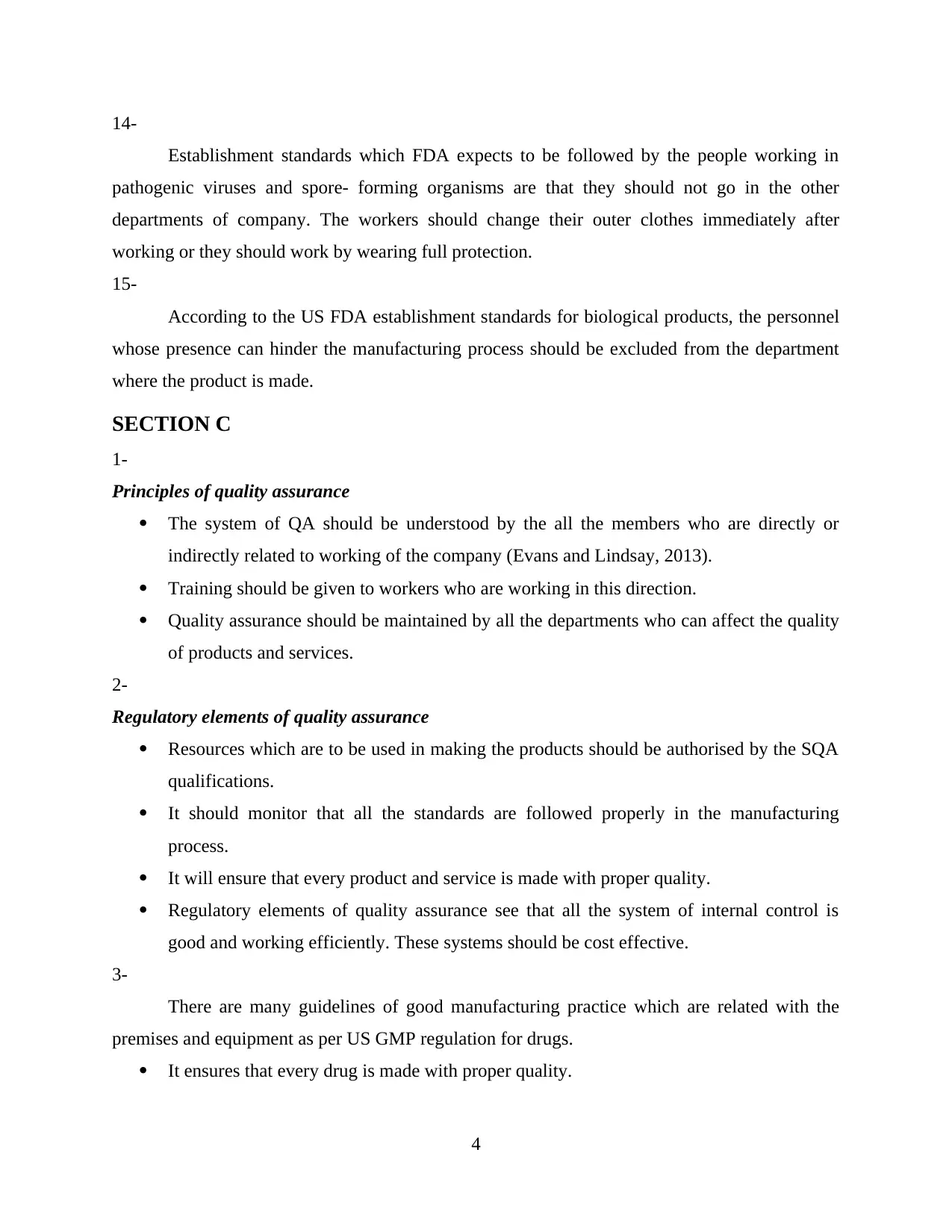
14-
Establishment standards which FDA expects to be followed by the people working in
pathogenic viruses and spore- forming organisms are that they should not go in the other
departments of company. The workers should change their outer clothes immediately after
working or they should work by wearing full protection.
15-
According to the US FDA establishment standards for biological products, the personnel
whose presence can hinder the manufacturing process should be excluded from the department
where the product is made.
SECTION C
1-
Principles of quality assurance
The system of QA should be understood by the all the members who are directly or
indirectly related to working of the company (Evans and Lindsay, 2013).
Training should be given to workers who are working in this direction.
Quality assurance should be maintained by all the departments who can affect the quality
of products and services.
2-
Regulatory elements of quality assurance
Resources which are to be used in making the products should be authorised by the SQA
qualifications.
It should monitor that all the standards are followed properly in the manufacturing
process.
It will ensure that every product and service is made with proper quality.
Regulatory elements of quality assurance see that all the system of internal control is
good and working efficiently. These systems should be cost effective.
3-
There are many guidelines of good manufacturing practice which are related with the
premises and equipment as per US GMP regulation for drugs.
It ensures that every drug is made with proper quality.
4
Establishment standards which FDA expects to be followed by the people working in
pathogenic viruses and spore- forming organisms are that they should not go in the other
departments of company. The workers should change their outer clothes immediately after
working or they should work by wearing full protection.
15-
According to the US FDA establishment standards for biological products, the personnel
whose presence can hinder the manufacturing process should be excluded from the department
where the product is made.
SECTION C
1-
Principles of quality assurance
The system of QA should be understood by the all the members who are directly or
indirectly related to working of the company (Evans and Lindsay, 2013).
Training should be given to workers who are working in this direction.
Quality assurance should be maintained by all the departments who can affect the quality
of products and services.
2-
Regulatory elements of quality assurance
Resources which are to be used in making the products should be authorised by the SQA
qualifications.
It should monitor that all the standards are followed properly in the manufacturing
process.
It will ensure that every product and service is made with proper quality.
Regulatory elements of quality assurance see that all the system of internal control is
good and working efficiently. These systems should be cost effective.
3-
There are many guidelines of good manufacturing practice which are related with the
premises and equipment as per US GMP regulation for drugs.
It ensures that every drug is made with proper quality.
4
⊘ This is a preview!⊘
Do you want full access?
Subscribe today to unlock all pages.

Trusted by 1+ million students worldwide
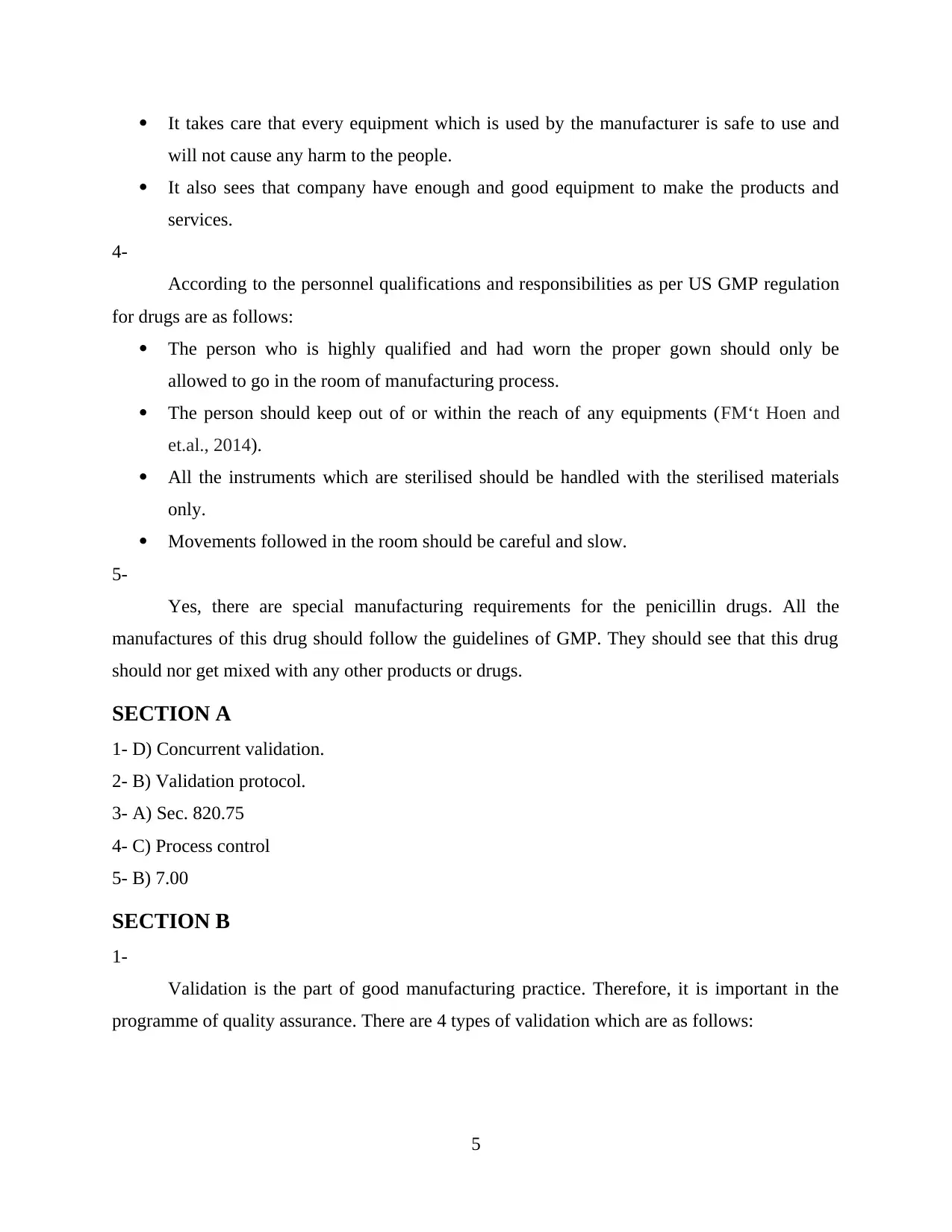
It takes care that every equipment which is used by the manufacturer is safe to use and
will not cause any harm to the people.
It also sees that company have enough and good equipment to make the products and
services.
4-
According to the personnel qualifications and responsibilities as per US GMP regulation
for drugs are as follows:
The person who is highly qualified and had worn the proper gown should only be
allowed to go in the room of manufacturing process.
The person should keep out of or within the reach of any equipments (FM‘t Hoen and
et.al., 2014).
All the instruments which are sterilised should be handled with the sterilised materials
only.
Movements followed in the room should be careful and slow.
5-
Yes, there are special manufacturing requirements for the penicillin drugs. All the
manufactures of this drug should follow the guidelines of GMP. They should see that this drug
should nor get mixed with any other products or drugs.
SECTION A
1- D) Concurrent validation.
2- B) Validation protocol.
3- A) Sec. 820.75
4- C) Process control
5- B) 7.00
SECTION B
1-
Validation is the part of good manufacturing practice. Therefore, it is important in the
programme of quality assurance. There are 4 types of validation which are as follows:
5
will not cause any harm to the people.
It also sees that company have enough and good equipment to make the products and
services.
4-
According to the personnel qualifications and responsibilities as per US GMP regulation
for drugs are as follows:
The person who is highly qualified and had worn the proper gown should only be
allowed to go in the room of manufacturing process.
The person should keep out of or within the reach of any equipments (FM‘t Hoen and
et.al., 2014).
All the instruments which are sterilised should be handled with the sterilised materials
only.
Movements followed in the room should be careful and slow.
5-
Yes, there are special manufacturing requirements for the penicillin drugs. All the
manufactures of this drug should follow the guidelines of GMP. They should see that this drug
should nor get mixed with any other products or drugs.
SECTION A
1- D) Concurrent validation.
2- B) Validation protocol.
3- A) Sec. 820.75
4- C) Process control
5- B) 7.00
SECTION B
1-
Validation is the part of good manufacturing practice. Therefore, it is important in the
programme of quality assurance. There are 4 types of validation which are as follows:
5
Paraphrase This Document
Need a fresh take? Get an instant paraphrase of this document with our AI Paraphraser
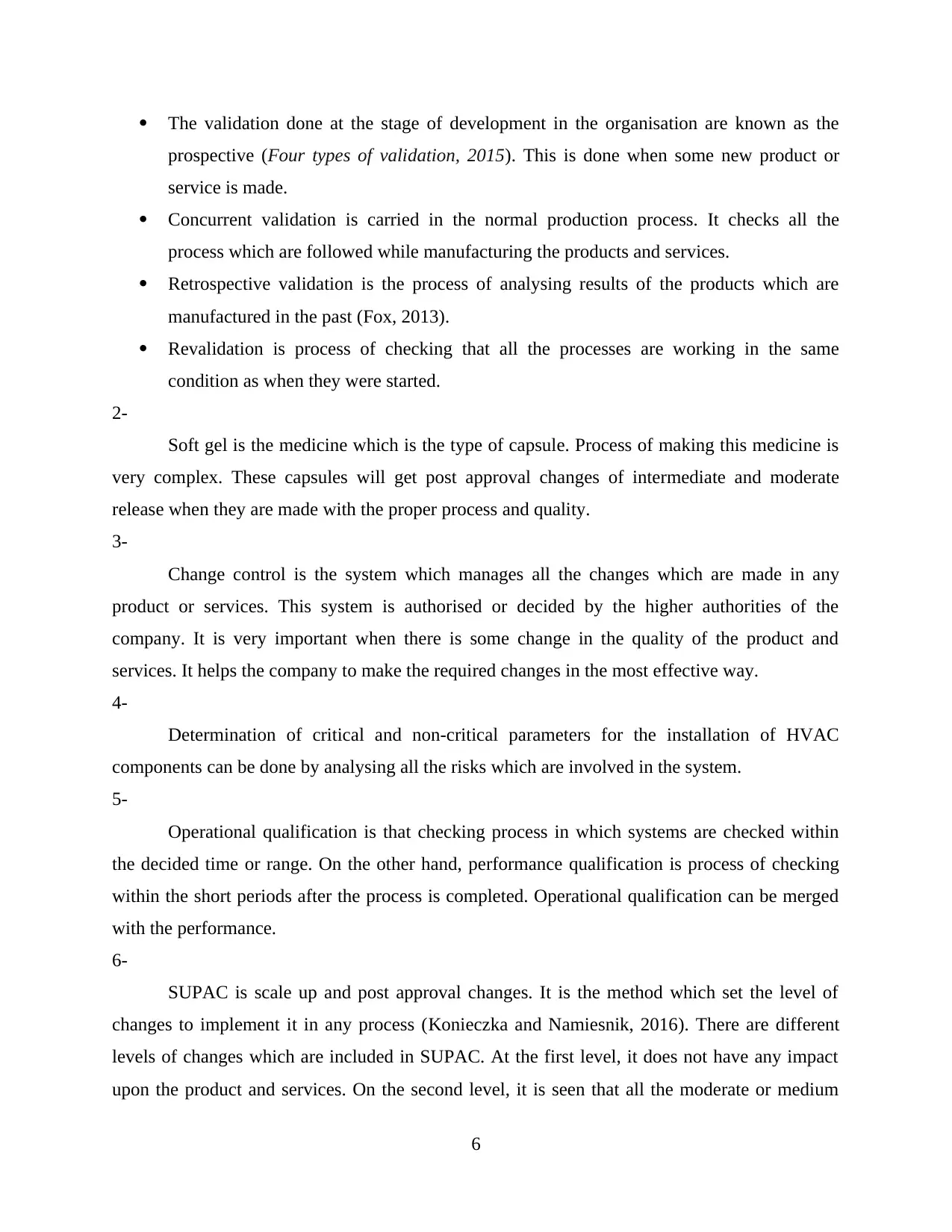
The validation done at the stage of development in the organisation are known as the
prospective (Four types of validation, 2015). This is done when some new product or
service is made.
Concurrent validation is carried in the normal production process. It checks all the
process which are followed while manufacturing the products and services.
Retrospective validation is the process of analysing results of the products which are
manufactured in the past (Fox, 2013).
Revalidation is process of checking that all the processes are working in the same
condition as when they were started.
2-
Soft gel is the medicine which is the type of capsule. Process of making this medicine is
very complex. These capsules will get post approval changes of intermediate and moderate
release when they are made with the proper process and quality.
3-
Change control is the system which manages all the changes which are made in any
product or services. This system is authorised or decided by the higher authorities of the
company. It is very important when there is some change in the quality of the product and
services. It helps the company to make the required changes in the most effective way.
4-
Determination of critical and non-critical parameters for the installation of HVAC
components can be done by analysing all the risks which are involved in the system.
5-
Operational qualification is that checking process in which systems are checked within
the decided time or range. On the other hand, performance qualification is process of checking
within the short periods after the process is completed. Operational qualification can be merged
with the performance.
6-
SUPAC is scale up and post approval changes. It is the method which set the level of
changes to implement it in any process (Konieczka and Namiesnik, 2016). There are different
levels of changes which are included in SUPAC. At the first level, it does not have any impact
upon the product and services. On the second level, it is seen that all the moderate or medium
6
prospective (Four types of validation, 2015). This is done when some new product or
service is made.
Concurrent validation is carried in the normal production process. It checks all the
process which are followed while manufacturing the products and services.
Retrospective validation is the process of analysing results of the products which are
manufactured in the past (Fox, 2013).
Revalidation is process of checking that all the processes are working in the same
condition as when they were started.
2-
Soft gel is the medicine which is the type of capsule. Process of making this medicine is
very complex. These capsules will get post approval changes of intermediate and moderate
release when they are made with the proper process and quality.
3-
Change control is the system which manages all the changes which are made in any
product or services. This system is authorised or decided by the higher authorities of the
company. It is very important when there is some change in the quality of the product and
services. It helps the company to make the required changes in the most effective way.
4-
Determination of critical and non-critical parameters for the installation of HVAC
components can be done by analysing all the risks which are involved in the system.
5-
Operational qualification is that checking process in which systems are checked within
the decided time or range. On the other hand, performance qualification is process of checking
within the short periods after the process is completed. Operational qualification can be merged
with the performance.
6-
SUPAC is scale up and post approval changes. It is the method which set the level of
changes to implement it in any process (Konieczka and Namiesnik, 2016). There are different
levels of changes which are included in SUPAC. At the first level, it does not have any impact
upon the product and services. On the second level, it is seen that all the moderate or medium
6
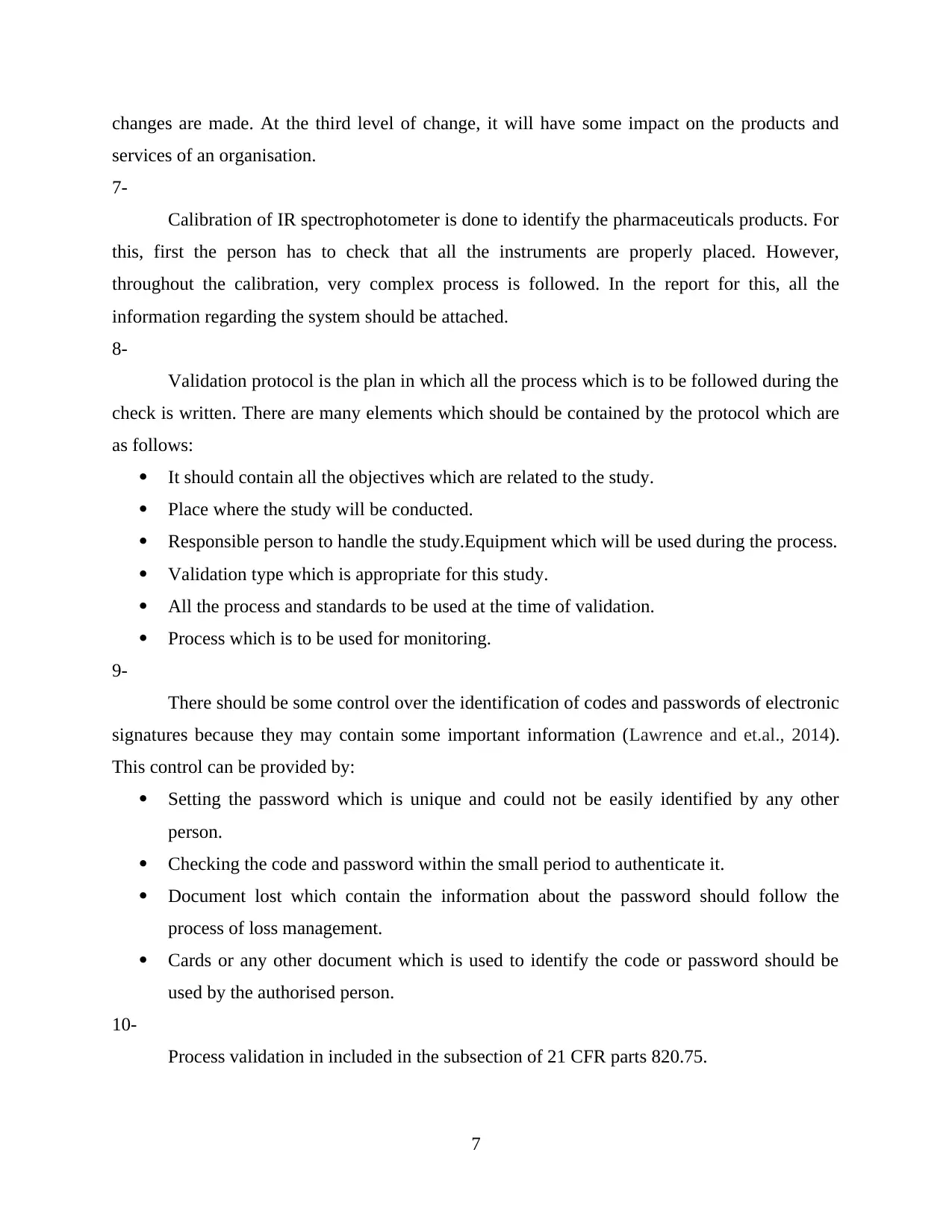
changes are made. At the third level of change, it will have some impact on the products and
services of an organisation.
7-
Calibration of IR spectrophotometer is done to identify the pharmaceuticals products. For
this, first the person has to check that all the instruments are properly placed. However,
throughout the calibration, very complex process is followed. In the report for this, all the
information regarding the system should be attached.
8-
Validation protocol is the plan in which all the process which is to be followed during the
check is written. There are many elements which should be contained by the protocol which are
as follows:
It should contain all the objectives which are related to the study.
Place where the study will be conducted.
Responsible person to handle the study.Equipment which will be used during the process.
Validation type which is appropriate for this study.
All the process and standards to be used at the time of validation.
Process which is to be used for monitoring.
9-
There should be some control over the identification of codes and passwords of electronic
signatures because they may contain some important information (Lawrence and et.al., 2014).
This control can be provided by:
Setting the password which is unique and could not be easily identified by any other
person.
Checking the code and password within the small period to authenticate it.
Document lost which contain the information about the password should follow the
process of loss management.
Cards or any other document which is used to identify the code or password should be
used by the authorised person.
10-
Process validation in included in the subsection of 21 CFR parts 820.75.
7
services of an organisation.
7-
Calibration of IR spectrophotometer is done to identify the pharmaceuticals products. For
this, first the person has to check that all the instruments are properly placed. However,
throughout the calibration, very complex process is followed. In the report for this, all the
information regarding the system should be attached.
8-
Validation protocol is the plan in which all the process which is to be followed during the
check is written. There are many elements which should be contained by the protocol which are
as follows:
It should contain all the objectives which are related to the study.
Place where the study will be conducted.
Responsible person to handle the study.Equipment which will be used during the process.
Validation type which is appropriate for this study.
All the process and standards to be used at the time of validation.
Process which is to be used for monitoring.
9-
There should be some control over the identification of codes and passwords of electronic
signatures because they may contain some important information (Lawrence and et.al., 2014).
This control can be provided by:
Setting the password which is unique and could not be easily identified by any other
person.
Checking the code and password within the small period to authenticate it.
Document lost which contain the information about the password should follow the
process of loss management.
Cards or any other document which is used to identify the code or password should be
used by the authorised person.
10-
Process validation in included in the subsection of 21 CFR parts 820.75.
7
⊘ This is a preview!⊘
Do you want full access?
Subscribe today to unlock all pages.

Trusted by 1+ million students worldwide
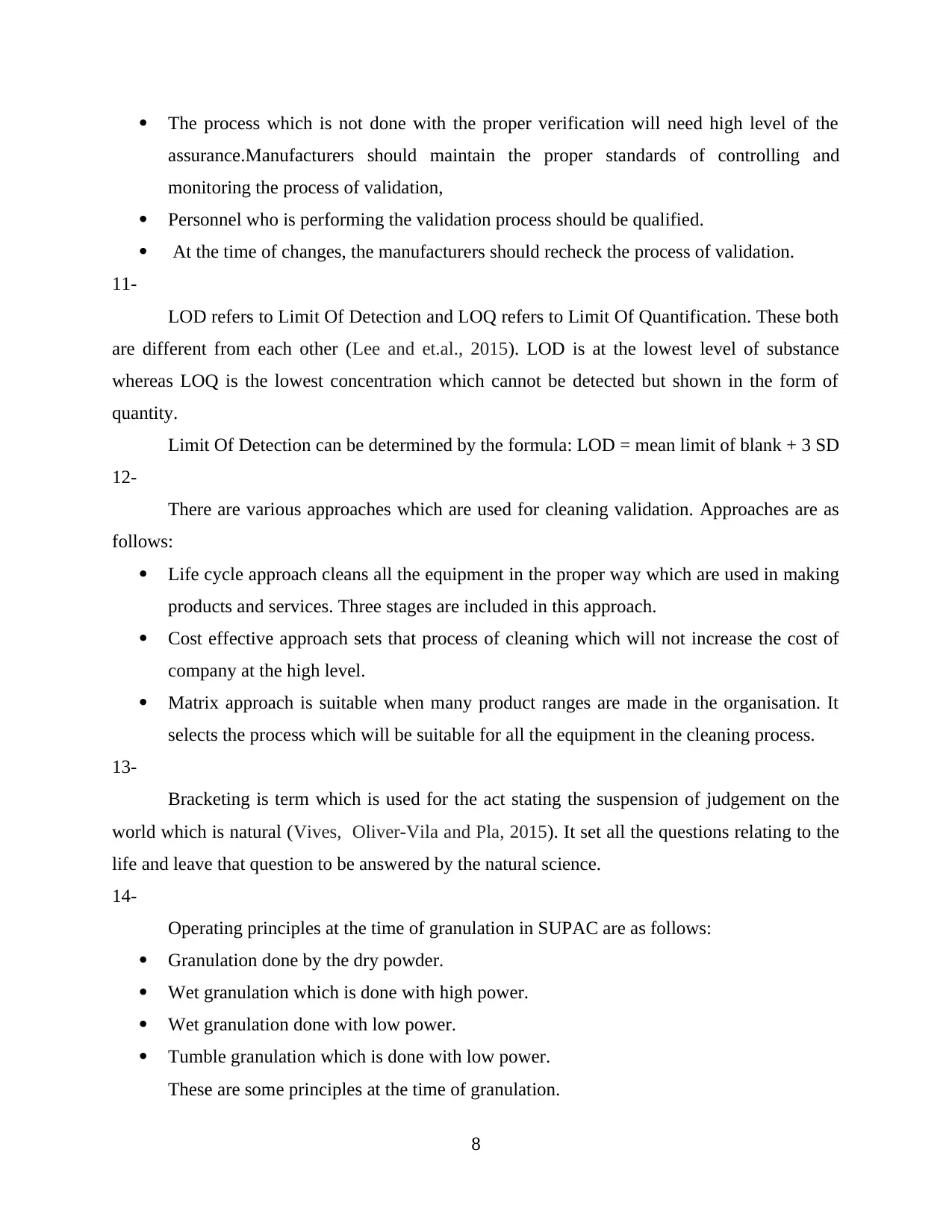
The process which is not done with the proper verification will need high level of the
assurance.Manufacturers should maintain the proper standards of controlling and
monitoring the process of validation,
Personnel who is performing the validation process should be qualified.
At the time of changes, the manufacturers should recheck the process of validation.
11-
LOD refers to Limit Of Detection and LOQ refers to Limit Of Quantification. These both
are different from each other (Lee and et.al., 2015). LOD is at the lowest level of substance
whereas LOQ is the lowest concentration which cannot be detected but shown in the form of
quantity.
Limit Of Detection can be determined by the formula: LOD = mean limit of blank + 3 SD
12-
There are various approaches which are used for cleaning validation. Approaches are as
follows:
Life cycle approach cleans all the equipment in the proper way which are used in making
products and services. Three stages are included in this approach.
Cost effective approach sets that process of cleaning which will not increase the cost of
company at the high level.
Matrix approach is suitable when many product ranges are made in the organisation. It
selects the process which will be suitable for all the equipment in the cleaning process.
13-
Bracketing is term which is used for the act stating the suspension of judgement on the
world which is natural (Vives, Oliver-Vila and Pla, 2015). It set all the questions relating to the
life and leave that question to be answered by the natural science.
14-
Operating principles at the time of granulation in SUPAC are as follows:
Granulation done by the dry powder.
Wet granulation which is done with high power.
Wet granulation done with low power.
Tumble granulation which is done with low power.
These are some principles at the time of granulation.
8
assurance.Manufacturers should maintain the proper standards of controlling and
monitoring the process of validation,
Personnel who is performing the validation process should be qualified.
At the time of changes, the manufacturers should recheck the process of validation.
11-
LOD refers to Limit Of Detection and LOQ refers to Limit Of Quantification. These both
are different from each other (Lee and et.al., 2015). LOD is at the lowest level of substance
whereas LOQ is the lowest concentration which cannot be detected but shown in the form of
quantity.
Limit Of Detection can be determined by the formula: LOD = mean limit of blank + 3 SD
12-
There are various approaches which are used for cleaning validation. Approaches are as
follows:
Life cycle approach cleans all the equipment in the proper way which are used in making
products and services. Three stages are included in this approach.
Cost effective approach sets that process of cleaning which will not increase the cost of
company at the high level.
Matrix approach is suitable when many product ranges are made in the organisation. It
selects the process which will be suitable for all the equipment in the cleaning process.
13-
Bracketing is term which is used for the act stating the suspension of judgement on the
world which is natural (Vives, Oliver-Vila and Pla, 2015). It set all the questions relating to the
life and leave that question to be answered by the natural science.
14-
Operating principles at the time of granulation in SUPAC are as follows:
Granulation done by the dry powder.
Wet granulation which is done with high power.
Wet granulation done with low power.
Tumble granulation which is done with low power.
These are some principles at the time of granulation.
8
Paraphrase This Document
Need a fresh take? Get an instant paraphrase of this document with our AI Paraphraser
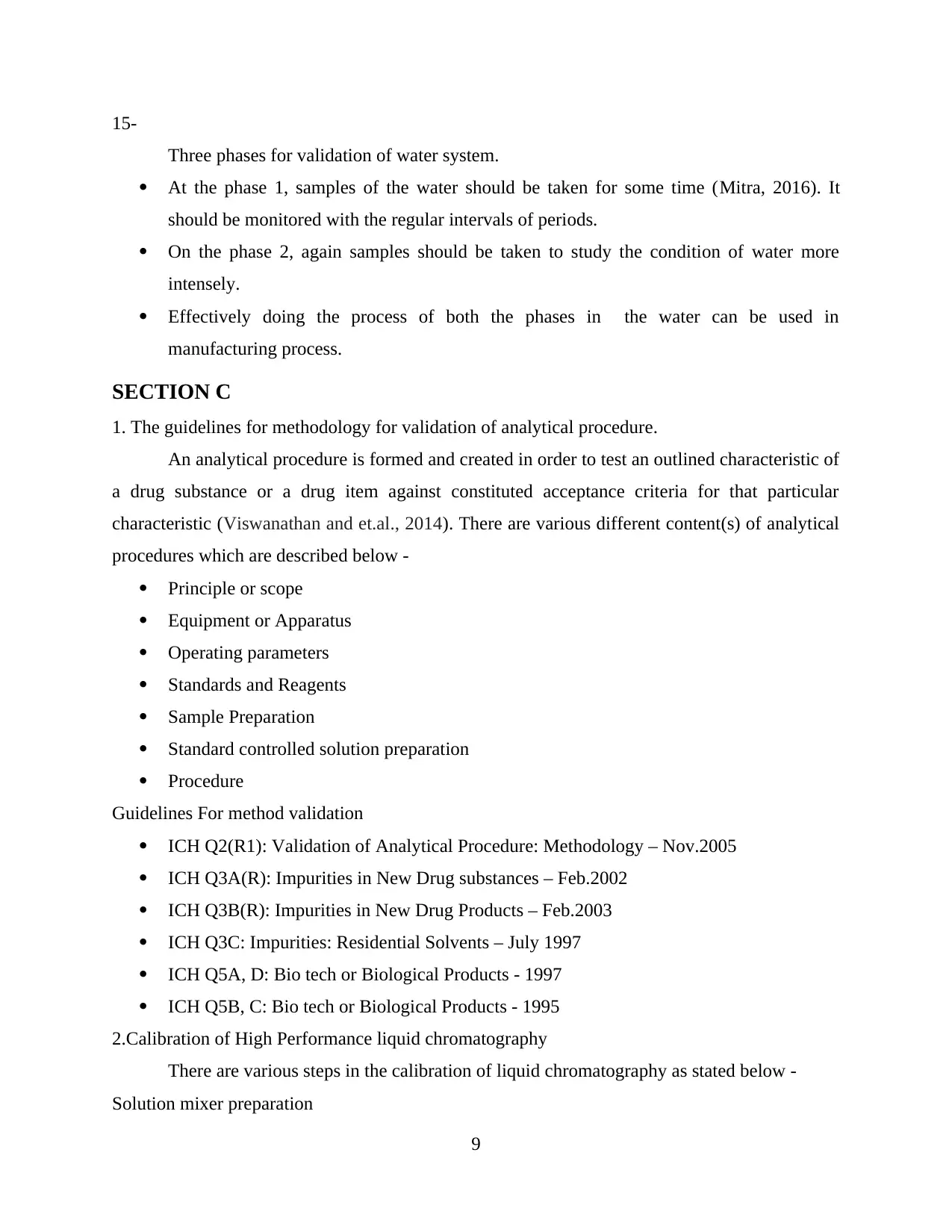
15-
Three phases for validation of water system.
At the phase 1, samples of the water should be taken for some time (Mitra, 2016). It
should be monitored with the regular intervals of periods.
On the phase 2, again samples should be taken to study the condition of water more
intensely.
Effectively doing the process of both the phases in the water can be used in
manufacturing process.
SECTION C
1. The guidelines for methodology for validation of analytical procedure.
An analytical procedure is formed and created in order to test an outlined characteristic of
a drug substance or a drug item against constituted acceptance criteria for that particular
characteristic (Viswanathan and et.al., 2014). There are various different content(s) of analytical
procedures which are described below -
Principle or scope
Equipment or Apparatus
Operating parameters
Standards and Reagents
Sample Preparation
Standard controlled solution preparation
Procedure
Guidelines For method validation
ICH Q2(R1): Validation of Analytical Procedure: Methodology – Nov.2005
ICH Q3A(R): Impurities in New Drug substances – Feb.2002
ICH Q3B(R): Impurities in New Drug Products – Feb.2003
ICH Q3C: Impurities: Residential Solvents – July 1997
ICH Q5A, D: Bio tech or Biological Products - 1997
ICH Q5B, C: Bio tech or Biological Products - 1995
2.Calibration of High Performance liquid chromatography
There are various steps in the calibration of liquid chromatography as stated below -
Solution mixer preparation
9
Three phases for validation of water system.
At the phase 1, samples of the water should be taken for some time (Mitra, 2016). It
should be monitored with the regular intervals of periods.
On the phase 2, again samples should be taken to study the condition of water more
intensely.
Effectively doing the process of both the phases in the water can be used in
manufacturing process.
SECTION C
1. The guidelines for methodology for validation of analytical procedure.
An analytical procedure is formed and created in order to test an outlined characteristic of
a drug substance or a drug item against constituted acceptance criteria for that particular
characteristic (Viswanathan and et.al., 2014). There are various different content(s) of analytical
procedures which are described below -
Principle or scope
Equipment or Apparatus
Operating parameters
Standards and Reagents
Sample Preparation
Standard controlled solution preparation
Procedure
Guidelines For method validation
ICH Q2(R1): Validation of Analytical Procedure: Methodology – Nov.2005
ICH Q3A(R): Impurities in New Drug substances – Feb.2002
ICH Q3B(R): Impurities in New Drug Products – Feb.2003
ICH Q3C: Impurities: Residential Solvents – July 1997
ICH Q5A, D: Bio tech or Biological Products - 1997
ICH Q5B, C: Bio tech or Biological Products - 1995
2.Calibration of High Performance liquid chromatography
There are various steps in the calibration of liquid chromatography as stated below -
Solution mixer preparation
9
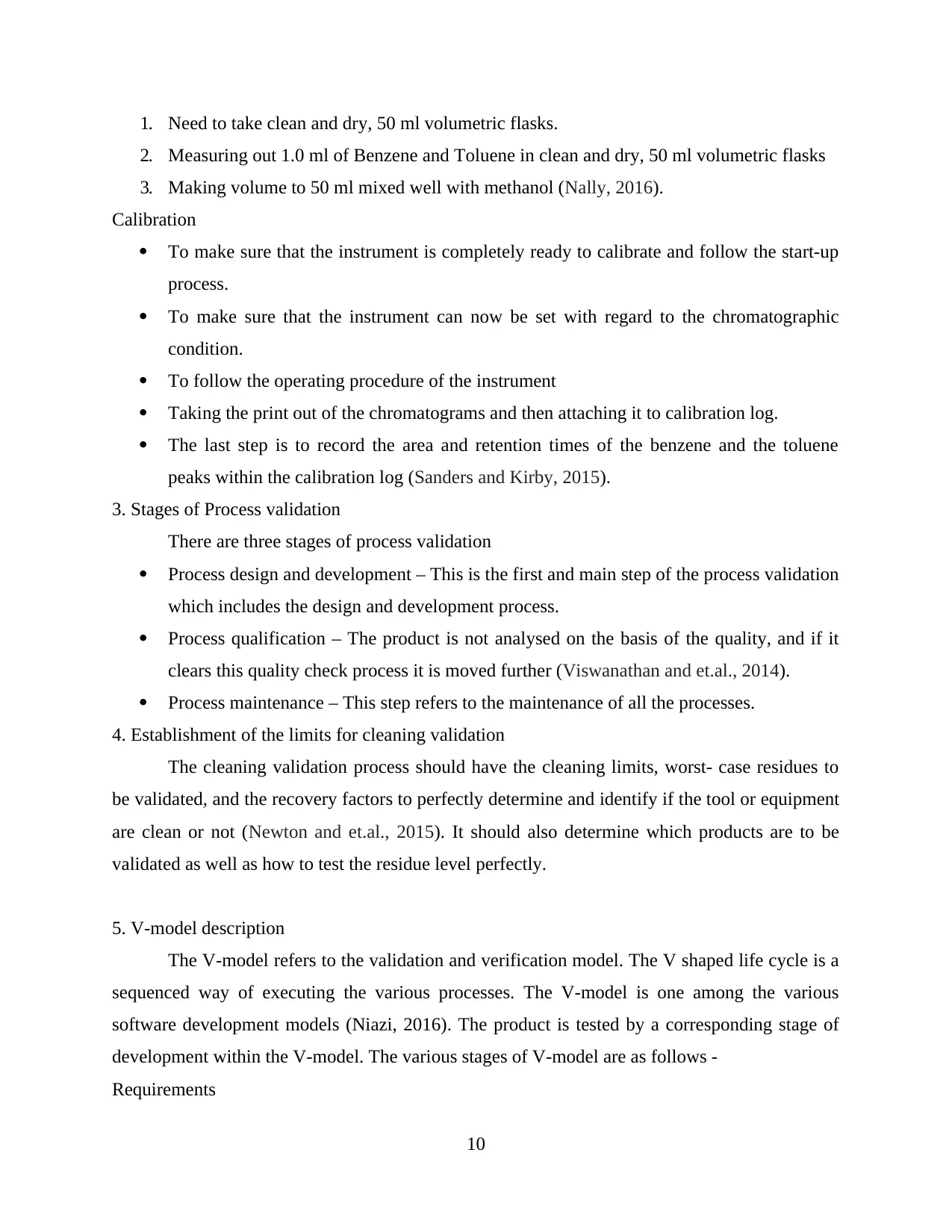
1. Need to take clean and dry, 50 ml volumetric flasks.
2. Measuring out 1.0 ml of Benzene and Toluene in clean and dry, 50 ml volumetric flasks
3. Making volume to 50 ml mixed well with methanol (Nally, 2016).
Calibration
To make sure that the instrument is completely ready to calibrate and follow the start-up
process.
To make sure that the instrument can now be set with regard to the chromatographic
condition.
To follow the operating procedure of the instrument
Taking the print out of the chromatograms and then attaching it to calibration log.
The last step is to record the area and retention times of the benzene and the toluene
peaks within the calibration log (Sanders and Kirby, 2015).
3. Stages of Process validation
There are three stages of process validation
Process design and development – This is the first and main step of the process validation
which includes the design and development process.
Process qualification – The product is not analysed on the basis of the quality, and if it
clears this quality check process it is moved further (Viswanathan and et.al., 2014).
Process maintenance – This step refers to the maintenance of all the processes.
4. Establishment of the limits for cleaning validation
The cleaning validation process should have the cleaning limits, worst- case residues to
be validated, and the recovery factors to perfectly determine and identify if the tool or equipment
are clean or not (Newton and et.al., 2015). It should also determine which products are to be
validated as well as how to test the residue level perfectly.
5. V-model description
The V-model refers to the validation and verification model. The V shaped life cycle is a
sequenced way of executing the various processes. The V-model is one among the various
software development models (Niazi, 2016). The product is tested by a corresponding stage of
development within the V-model. The various stages of V-model are as follows -
Requirements
10
2. Measuring out 1.0 ml of Benzene and Toluene in clean and dry, 50 ml volumetric flasks
3. Making volume to 50 ml mixed well with methanol (Nally, 2016).
Calibration
To make sure that the instrument is completely ready to calibrate and follow the start-up
process.
To make sure that the instrument can now be set with regard to the chromatographic
condition.
To follow the operating procedure of the instrument
Taking the print out of the chromatograms and then attaching it to calibration log.
The last step is to record the area and retention times of the benzene and the toluene
peaks within the calibration log (Sanders and Kirby, 2015).
3. Stages of Process validation
There are three stages of process validation
Process design and development – This is the first and main step of the process validation
which includes the design and development process.
Process qualification – The product is not analysed on the basis of the quality, and if it
clears this quality check process it is moved further (Viswanathan and et.al., 2014).
Process maintenance – This step refers to the maintenance of all the processes.
4. Establishment of the limits for cleaning validation
The cleaning validation process should have the cleaning limits, worst- case residues to
be validated, and the recovery factors to perfectly determine and identify if the tool or equipment
are clean or not (Newton and et.al., 2015). It should also determine which products are to be
validated as well as how to test the residue level perfectly.
5. V-model description
The V-model refers to the validation and verification model. The V shaped life cycle is a
sequenced way of executing the various processes. The V-model is one among the various
software development models (Niazi, 2016). The product is tested by a corresponding stage of
development within the V-model. The various stages of V-model are as follows -
Requirements
10
⊘ This is a preview!⊘
Do you want full access?
Subscribe today to unlock all pages.

Trusted by 1+ million students worldwide
1 out of 16
Related Documents
Your All-in-One AI-Powered Toolkit for Academic Success.
+13062052269
info@desklib.com
Available 24*7 on WhatsApp / Email
![[object Object]](/_next/static/media/star-bottom.7253800d.svg)
Unlock your academic potential
Copyright © 2020–2025 A2Z Services. All Rights Reserved. Developed and managed by ZUCOL.





